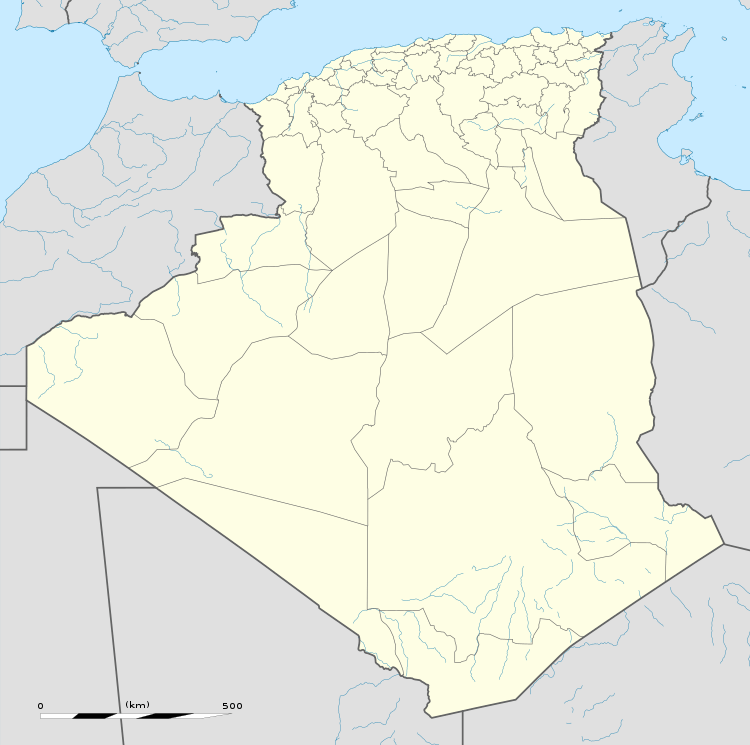Aïn El Berd
Aïn El Berd is a commune (baladiyah) in the Aïn El Berd district (daïra) in the Sidi Bel Abbès province (wilayah) of Algeria. It is situated in the northwestern part of the country, in the Hauts Plateaux region, and has a typical Mediterranean climate. Established as an official commune on April 15, 1886,[1] Aïn El Berd is known for its beautiful countryside views and sites, as well as for its vineyards, olive trees, and wheat products. During the French colonial era, the surrounding areas, then called Saint-Marc and Saint-Henri, gave wines of good quality, and in 1889 and 1900 won silver and gold medals, respectively.[2]
Aïn El Berd عين البرد Oued Imbert | |
|---|---|
 Aïn El Berd Location of Aïn El Berd in Algeria | |
| Coordinates: 35°21′57″N 0°30′46″W | |
| Country | |
| Province (Wilaya) | Sidi Bel Abbès |
| District (Daïra) | Aïn El Berd |
| Commune Established | April 15, 1886 |
| Area | |
| • Total | 84 km2 (32 sq mi) |
| Elevation | 486 m (1,594 ft) |
| Population (2008) | |
| • Total | 16,013 |
| • Density | 190.6/km2 (494/sq mi) |
| Time zone | UTC+1 (CET) |
| Area code(s) | 48 |
Settlements
Aïn El Berd Commune consists of two main settlements:
- Aïn El Berd - with a population of 12,179[3][4] is the capital of Aïn El Berd commune. The colonial name was "Oued-Imbert", which is a contraction of its name Oued Aïn El Berd.[2] Before the French colonial era, Aïn El Berd was inhabited by the tribe of Ouled Sidi Ma'âchou.[5] It is situated 25 km from Sidi Bel Abbès and 57 km from Oran on national highway N13.
- Ouled Ali - population of 3,487.[3]
Demographics
During the French colonial era, the area around Aïn El Berd from Oran to Sidi-Bel-Abbès was heavily populated with French colonists,[6] sometimes referred to as Pied-Noir. After the massacre of Pieds-Noirs in Oran by the suburban Muslim population in which European people were shot, molested and brought to Petit-Lac slaughterhouse where they were tortured and executed,[7] the Pied-Noir exodus began in earnest.[8][9][10] By September 1962, cities such as Oran and Sidi Bel Abbès were half-empty.
Despite losing so many people in the Pied-Noir exodus, the region is currently rebounding. The population of the commune in 1933 was 41,645.[2] In 1998 the population was 13,779.[11] And according to the 2008 census, the population was 16,013.[4][11]
Other
- Aïn El Berd is the location of the mausoleum of Sidi (Saint) Ma'âchou, which attracts visitors from all around north-western Algeria.
- There is a celebration every autumn - the Waada of Aïn El Berd.
- Nearby spring: 'Ain Melegra 35°22′25.07″N 0°28′9.7″W
- Nearby hill: Hammar Zahtar 35°20′45.6″N 0°28′19.96″W
- Nearby mountain: Djebel Boû Rdjiyâ 35°22′51.24″N 0°32′44.38″W
See also
References
- "Recherche géographique". anom.archivesnationales.culture.gouv.fr (in French). Retrieved 2018-09-08.
- csaulnier (2016-10-29). "OUED IMBERT : Son histoire". Skyrock (in French). Retrieved 2018-09-08.
- "Aïn El Berd (Commune, Sidi bel Abbès, Algeria) - Population Statistics, Charts, Map and Location". www.citypopulation.de. Retrieved 2018-09-08.
- "Répartition de la population résidente des ménages ordinaires et collectifs, selon la commune de résidence et la dispersion" (PDF). 2008.
- oueldserkhane (2011-06-26). "Ain El Berd - Oued Imbert : Cartes postales anciennes". Skyrock (in French). Retrieved 2018-09-08.
- Hourani, Albert Habib; Hourani, Albert; Ruthven, Malise (2002). A History of the Arab Peoples. Harvard University Press. ISBN 9780674010178.
- Jean Monneret (2006). La tragédie dissimulée: Oran, 5 juillet 1962. Michalon. ISBN 978-2-84186-308-2.
- Naylor, Phillip Chiviges (December 2000). France and Algeria: A History of Decolonization and Transformation. University Press of Florida. ISBN 9780813030968.
- Smith, Andrea L. (2006). Colonial Memory and Postcolonial Europe: Maltese Settlers in Algeria and France. Indiana University Press. ISBN 025321856X.
- Shepard, Todd (2006). The Invention of Decolonization: The Algerian War and the Remaking of France. Cornell University Press. ISBN 0801443601.
- "Aïn El Berd (Commune, Sidi Bel Abbès, Algeria) - Population Statistics, Charts, Map and Location". www.citypopulation.de. Retrieved 2018-09-08.
External links
- http://enfantdeouedimbert.free.fr/livre1.html (website with map and photos of Aïn El Berd city)
.svg.png)